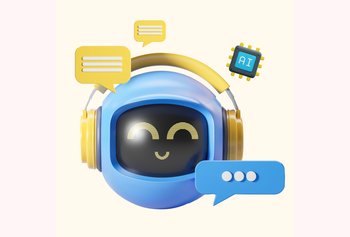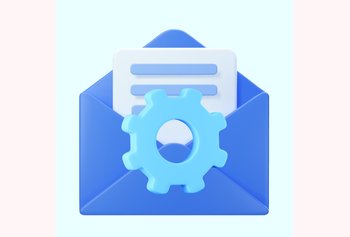Zendesk vs. Hubspot Service Hub – A Detailed Comparison
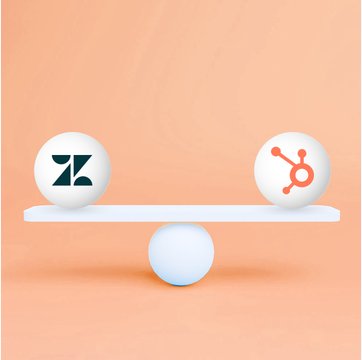
Table of contents
If you’re looking for a customer service platform, there’s a very good chance that you’d have stumbled upon Zendesk and HubSpot Service Hub when doing research. I’m confident in my guess because both these tools are quite popular.
Zendesk, for instance, is known for its comprehensive multi-channel support features, helping companies assist customers across email, chat, and phone, amongst other touchpoints. It also offers powerful automations and AI capabilities that can scale the efficiency of support teams.
HubSpot Service Hub also includes essential features such as ticketing, automation, customer feedback surveys, and a customer portal. These help support teams personalize customer conversations and enable them to set up a knowledge base that promotes self-service. Another highlight of Service Hub is its free plan, which can be used by businesses working on a tight budget.
But which is better, Zendesk or HubSpot Service Hub? We’ve compared the two tools to present their pros and cons.
Table of Contents
- Zendesk VS Hubspot Service Hub: Quick Comparison
- Zendesk Overview
- Hubspot Service Hub Overview
- Zendesk vs Hubspot Service Hub: What should you choose?
- 1. Ease of Use
- 2. Automation and AI
- 3. Omnichannel Functionalities
- 4. Reporting and Analytics
- 5. Pricing
- Customer Support Quality
- 7. Third-party Integrations
- …Or simply choose Hiver, a better alternative.
- 1. Gmail Interface
- 2. Shared Inboxes
- 3. Email Management
- 4. Enhancing Collaboration
- 5. Advanced Automation
- 6. Analytics and Reporting
- 7. Pricing Structure
- 8. Proactive Customer Support
Zendesk VS Hubspot Service Hub: Quick Comparison
| Zendesk | Hubspot | |
|---|---|---|
| Price | Starts at $19/month per agent | Free; $15 per month (billed annually) |
| Free Trial | 14-day free trial | 14-day free trial |
| Ease of use | User-friendly interface, but may require some learning to use advanced features | Intuitive and easy to navigate, even for beginners |
| Automation and AI | Advanced automation, AI-driven bots, Answer Bot, and predictive analytics | Includes workflows, chatbots, and predictive lead scoring |
| Omnichannel Support | Email, chat, social media, phone, community forum, knowledge base, web form, web service, and web widget. | Email, live chat, social media, phone, and chatbots. |
| Reporting and Analytics | Custom reports, data export, and Zendesk exploration. (available only on paid plans) | Customizable reports and dashboards. Ability to track key customer service metrics. |
| Customer Support Quality | Support is difficult to reach for primary plan users; personalized support services are available at the higher-tier subscription levels. | Available 24×5, covering in-app, phone, email, and chat support for both the Professional and Enterprise plans |
| Third-Party Integrations | Over 1500 integrations | Integrates with over 1000 apps |
| Reviews | Check Zendesk Review | Check Hubspot Review |
| Demo | Try Zendesk | Try Hubspot |
Zendesk Overview
Zendesk is customer support software mostly used by rapidly scaling companies or large enterprises. It offers a wide range of ticketing features that help support teams streamline customer queries across several touchpoints—email, chat, phone, and social media, to name a few. Zendesk also offers numerous integrations with CRM software, project management tools, and e-commerce platforms.

Zendesk’s app marketplace offers various extensions and add-ons for specific business needs, such as real-time language translation and sentiment analysis. The platform’s robust reporting and analytics tools aid in making data-driven decisions by analyzing support metrics like ticket volume, average resolution time, and customer satisfaction scores.
Hubspot Service Hub Overview
HubSpot’s Service Hub is software designed to help businesses build long-lasting customer relationships through easy-to-use features. It provides conversational tools, a shared inbox, help desk automation, knowledge base functionality, customer feedback surveys, and more.
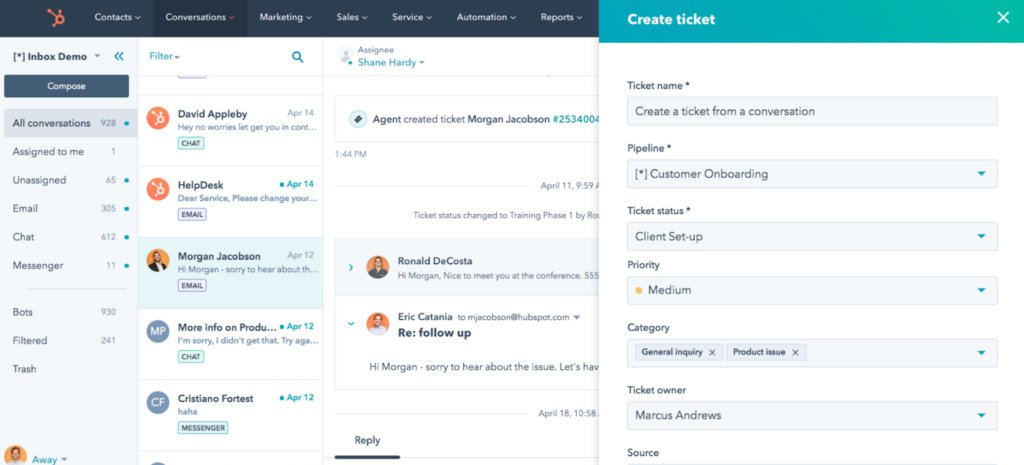
Service Hub is powered by HubSpot’s AI-powered Smart CRM, which provides a unified view of all customer interactions. The software is available in free and premium plans, catering to businesses of different sizes and needs.
Its key strengths include a customer portal, omnichannel messaging, inbound calling, live chat, and VoIP calling, all of which aim to enhance customer service management and build stronger customer relationships.
Zendesk vs Hubspot Service Hub: What should you choose?
Let’s examine the strengths and weaknesses of both Zendesk and HubSpot Service Hub based on various decision-making factors.
1. Ease of Use
When comparing the ease of use between Zendesk and HubSpot Service Hub for the year 2024, there are several vital aspects to consider:
Zendesk

Agent experience: Zendesk, as a customer service platform, receives a range of feedback regarding its ease of use and setup process. Some users like its solid features and efficiency, especially its good administrative capabilities and the smooth handling of customer interactions through features like real-time chats. This positive feedback shows that Zendesk is effective in managing customer support operations.
On the other hand, some users find Zendesk challenging, especially when integrating it with other systems and tools. Issues such as setup complexity and ticket management difficulties across multiple teams are mentioned. These challenges indicate that while Zendesk is a powerful tool with extensive functionalities, its effectiveness can vary based on the specific implementation and integration within an organization’s infrastructure.
Recommended Reading: How itGenius saved 40 hours a month by moving from Zendesk to Hiver
HubSpot Service Hub

Agent Workspace: The platform is noted for its ease of use, although it may initially feel overwhelming due to the multitude of options available. It is highly praised for its ability to streamline customer support through features such as a multi-channel ticketing system, live chat, and a comprehensive knowledge base. Users find these features helpful for organizing and prioritizing customer queries and issues.
HubSpot effectively ties its various systems together, reducing the need for users to switch between different software. This integration is particularly valued by businesses that use HubSpot’s full suite of products, including the Service Hub.
Key Takeaway
Zendesk, known for its scalability and advanced features, offers a versatile platform suitable for complex customer support needs. However, it can be more complicated to set up and use. In contrast, HubSpot Service Hub provides a more straightforward interface but may lack some of Zendesk’s advanced collaboration and customization capabilities. This distinction is essential for businesses considering the right balance between functionality and ease of use.
2. Automation and AI
When comparing the automation and AI features of Zendesk and HubSpot, both platforms offer distinctive strengths and weaknesses.
Zendesk:
Zendesk offers comprehensive automation and AI capabilities to streamline customer support processes and enhance the overall customer experience.
Here’s a breakdown of Zendesk’s automation and AI features:

- Automated Ticket Routing and Handling: Zendesk uses AI and machine learning to automatically route tickets to the appropriate agent or department based on their expertise and workload. This feature ensures that customer inquiries are addressed by the most qualified person, improving resolution times and customer satisfaction.
- AI-Powered Chatbots: Zendesk helps businesses use AI-driven chatbots to handle routine inquiries and respond instantly to frequently asked questions. This not only improves speed of support by providing quicker answers to customers but also reduces the workload on human agents.
- Trigger-Based Actions: Zendesk enables the creation of triggers that automate specific actions based on certain conditions. For instance, a trigger can be configured to send an automated response when a new ticket is created or to escalate a ticket if it has not been resolved within a specific timeframe.
Intent and Sentiment Analysis: Zendesk’s AI can analyze the intent behind customer inquiries and the sentiment of their messages. This helps prioritize tickets and tailor responses based on the urgency and tone of the request.
Recommended Reading: Download the ‘AI vs Human | The Future of Customer Service in 2024’ Report
HubSpot Service Hub:
HubSpot Service Hub offers automation features to streamline customer service processes and enhance efficiency. Here’s an overview of the key automation capabilities of HubSpot Service Hub:

- Workflow Automation: HubSpot Service Hub offers robust workflow automation features that allow businesses to automate repetitive tasks and processes. These workflows can be triggered based on specific actions or events, like ticket creation, customer responses, or status changes. This automation helps reduce manual workload and improve response times.
- Ticketing System Automation: The platform allows for the automation of ticket management, which includes assigning tickets to the right team or agent, changing ticket status, and escalating issues based on predefined criteria. This ensures that customer inquiries are handled promptly and by the most appropriate personnel.
- Live Chat and Conversational Bots: HubSpot offers live chat capabilities and conversational bots to engage customers in real-time on the website. These bots can instantly respond to common queries, gather customer information, and route conversations to human agents when necessary.
- Email Templates and Sequences: HubSpot’s automation includes email management, allowing businesses to utilize pre-built email templates and create automated email sequences. This feature is helpful for follow-up communications and standardizing responses to common customer inquiries.
- Task and Lead Management: Service Hub automates various aspects of task and lead management, including assigning tasks to team members based on workload or expertise, setting reminders, and tracking the progress of sales leads.
- Customizable Pipelines: HubSpot enables the creation of service pipelines to track and manage customer issues efficiently. These pipelines can be customized to match a company’s service process stages, providing a clear overview of customer inquiries and their statuses.
Recommended Reading: 9 Automations to Implement in Ticketing Systems
Key Takeaway
Zendesk shines with AI-driven chatbots and automated ticket routing, which is ideal for businesses with advanced customer support automation.
With its integrated CRM, HubSpot excels in workflow automation and email management, which is suitable for companies wanting a unified customer service and CRM platform.
Your choice depends on whether you prioritize AI capabilities (Zendesk) or a combined CRM-customer service system (HubSpot).
3. Omnichannel Functionalities
Let’s explore how these platforms cater to diverse customer engagement needs with their distinct omnichannel features.
Zendesk
Email: Zendesk converts incoming emails into support tickets. This helps support teams track, prioritize, and respond to customer emails alongside other support channels within the same interface. Every email interaction becomes part of a unified customer support thread, preserving and easily accessible the context and history of customer interactions.
Community Forum: Zendesk’s Community Forum feature allows businesses to create a dynamic space where customers can engage with each other. This platform is a hub for users to ask questions, share insights, and offer solutions based on their experiences. It’s an effective way for a company to build a community around its brand, fostering peer-to-peer support and customer engagement. The forum also acts as a valuable feedback tool, where businesses can gather insights directly from their customers, helping them understand their needs and preferences better.

- Knowledge Base: The Zendesk Knowledge Base (Zendesk Guide) is a central repository of information. It allows customers to find answers to common questions and learn about different aspects of products or services. This self-service feature helps customers resolve issues independently, reducing the need for direct contact with support agents.
- Live Chat (Zendesk Chat): Zendesk Chat helps businesses provide real-time assistance to customers browsing their websites. This feature is essential for engaging customers at critical moments, such as making purchase decisions or needing immediate help. Live chat can enhance customer satisfaction by offering instant responses and personalized support.
- Messaging Platforms: Zendesk supports a wide array of messaging platforms, catering to the diverse preferences of a business’s customers. These include popular messaging apps like WhatsApp, Facebook Messenger, LINE, SMS, Telegram, and WeChat. Integrating these platforms into Zendesk allows businesses to manage conversations across different messaging apps within a single interface.
- Phone Support (Inbound and Outbound Calls): Zendesk also offers strong phone support capabilities, including inbound and outbound call functions. The system seamlessly integrates with traditional telephony and VoIP services, enabling businesses to manage phone-based customer interactions effectively. This encompasses call routing, call recording, and creating support tickets from phone calls.
- Web Form and Web Service (API): These features allow businesses to integrate support functionalities directly into their websites or applications, enabling customers to submit queries or requests without leaving the platform.
- Social Media Integration: Zendesk offers integrations with major social media platforms such as Facebook and Twitter, enabling businesses to effectively manage and respond to customer interactions on these platforms directly from the Zendesk interface.
- Mobile SDK and Web Widget: Businesses can integrate Zendesk’s support functionalities into their mobile apps and websites using the Mobile SDK and Web Widget, respectively. This offers a more cohesive experience for users accessing support through these channels.
Recommended Reading: Discover the 7 Best Omnichannel Helpdesk for Customer Support
HubSpot Service Hub:

- Live Chat: This feature lets your company have real-time, personalized conversations with customers on your website. It’s integrated into HubSpot’s CRM, storing chat conversations for complete context, and is customizable to align with your brand’s aesthetics. The live chat widget can be targeted to specific web pages or visitor segments and can escalate from chatbot interactions to live human support.
- Email: A fundamental channel within HubSpot Service Hub, email facilitates formal and structured customer communication. Integrated into the CRM, teams can assign emails, track their status, and organize them into different categories, providing a streamlined communication channel within the HubSpot ecosystem.
- Facebook Messenger: This integration allows seamless customer communication through a popular social media platform. Integrating Facebook Messenger into HubSpot provides a smooth transition from social media interaction to direct customer support, enhancing the overall customer experience.
- Conversational Bots: HubSpot’s chatbots assist live chat by handling routine questions, directing customers to relevant documents or chat agents, and offering customization for specific pages or visitor groups.
- Phone Support: HubSpot’s phone support feature allows direct calling from the account and integrates and logs phone conversations into the CRM for detailed customer interaction histories.
Key Takeaway
If omnichannel functionality is the top priority, Zendesk has a slight edge due to its more advanced and diverse offerings. However, if you’re looking for a more integrated approach that aligns customer service with marketing and sales, HubSpot Service Hub is also a strong contender.
4. Reporting and Analytics
When comparing the reporting and analytics capabilities of Zendesk and HubSpot Service Hub, both platforms offer a range of features that cater to different business needs.
Zendesk:
Customizable Reporting: Zendesk allows you to create custom reports to meet specific business needs. These reports can be tailored based on metrics and attributes relevant to your business, like ticket volume, response time, and customer feedback.

- Dashboard Overview: A glance at key metrics and trends, helping businesses get an overview of performance indicators.
- Ticket Views: This feature enables ticket sorting and filtering, which aids in a deeper understanding of customer needs and patterns in customer requests.
- Performance Reports: Track customer service teams’ performance and identify improvement areas.
- Satisfaction Ratings: Zendesk helps monitor customer satisfaction scores, ensuring businesses deliver a good support experience.
- Data Export: Businesses can export data in various formats, such as CSV, PDF, and XLS, for further analysis or reporting purposes.
- API Integrations: Zendesk offers integration with popular API providers such as Twilio, Slack, and Salesforce, enhancing its reporting capabilities.
- Zendesk Explore: Zendesk Explore is a vital component of Zendesk’s reporting tool. It helps businesses collect, analyze, and act on customer service data. The service offers pre-built and customizable dashboards to display information about Zendesk products, allowing businesses to focus on their most relevant operational indicators.
Recommended Reading: 18 Key Customer Service Metrics and How to Use Them
HubSpot Service Hub:
- Service Analytics: This tool provides a clear overview of key customer support metrics, including response time, support volume, and customer satisfaction scores (CSAT). These metrics are presented as user-friendly, making complex data easily accessible for individuals without specialized analytical skills.

- Customizable Reports and Dashboards: Users can create customized reports and dashboards to monitor essential service metrics, such as ticket volume, resolution time, and customer satisfaction. This enables continuous data analysis to identify areas for improvement and make informed decisions to enhance service strategies.
- Types of Service Reports: Access reports that provide insights into customer satisfaction and agent performance. These reports offer detailed information on post-support interaction CSAT scores, average ticket closure times, chat wait times, and support volume, among other metrics.
Key Takeaway
Zendesk is great for detailed, customizable reporting and analytics, which is ideal for businesses that require tailored insights into customer support metrics such as ticket volume and response times.
On the other hand, HubSpot Service Hub offers a more user-friendly approach with easy-to-understand analytics, perfect for companies that want a straightforward overview of key customer service metrics. Your decision should be based on whether you need depth and customization (Zendesk) or simplicity and accessibility (HubSpot).
5. Pricing
Zendesk and HubSpot show significant differences in pricing structures, with each platform adopting distinct pricing strategies to cater to various business sizes and requirements.
Zendesk
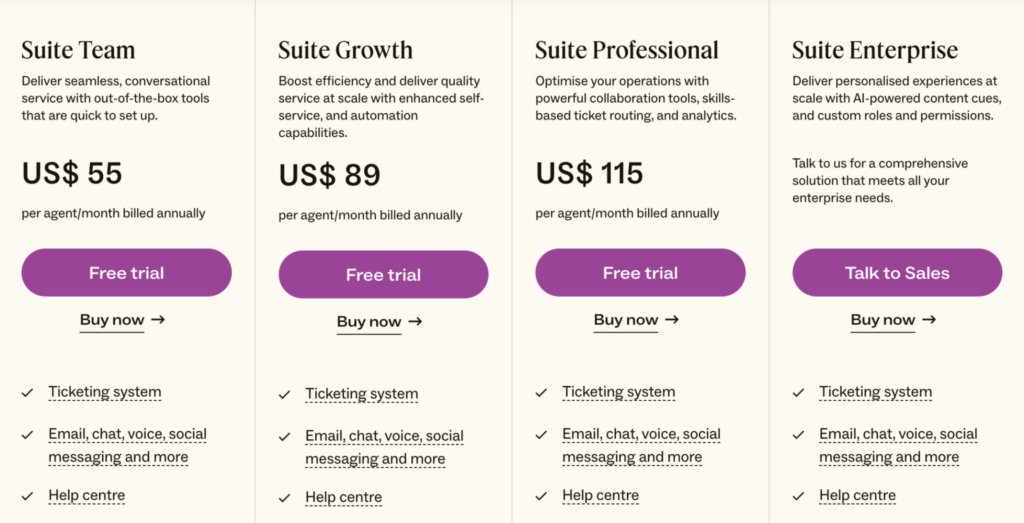
- Suite Team: The starting price is $55 per agent per month when billed annually and includes basic features like email support, messaging, live chat, and access to social and business channels.
- Suite Growth: The plan is $89 per agent per month annually. It includes advanced features like social and business channels and voice support with add-ons.
- Suite Professional: At $115 per agent per month when billed annually, this plan offers even more advanced features, including multilingual content, advanced knowledge management, and bots.
- Suite Enterprise: For larger businesses, this plan costs $169 per agent per month annually. It includes extensive features like unlimited departments, advanced encryption, and advanced data retention policies.
Recommended Reading: Zendesk costs 2x more than Hiver
Hubspot Service Hub
HubSpot Service Hub offers various pricing options to meet different business needs. The Professional tier is tailored for small teams and starts at $450 per month with an annual commitment of $5,400 per year. This plan includes five paid users and provides features like comprehensive help desk software, service analytics, customer portals, feedback surveys, and playbooks.
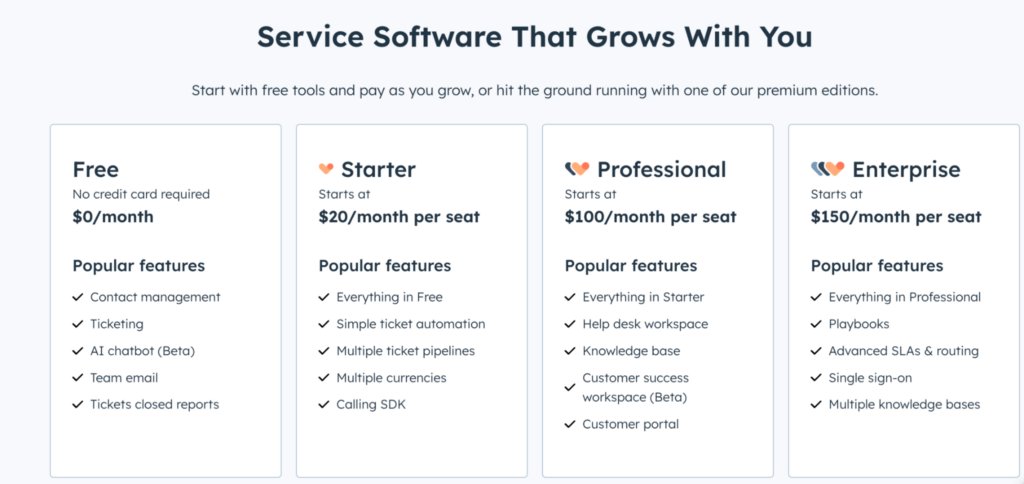
The Enterprise tier is for larger enterprises with advanced features and flexibility. It starts at $1,200 per month or $14,400 annually. It includes ten paid users, with each extra user costing $120 per month.
Key Takeaway
Zendesk is a good choice for smaller teams that need scalability, while HubSpot Service Hub suits larger teams looking for value in various features. More importantly, if you’re already using HubSpot CRM, opting for HubSpot Service Hub makes sense to integrate customer service with your existing CRM system seamlessly. This integration can offer streamlined operations and a unified approach to managing customer relationships.
Customer Support Quality
Assessing the quality of customer support offered by Zendesk and HubSpot, each platform reveals unique approaches, prioritizing different aspects of the customer service experience.
Zendesk
Users of Zendesk’s basic plans may find customer support challenging. The company tends to allocate more sophisticated support services to higher-tier subscription levels.
This can pose a hurdle for smaller enterprises or those with limited resources.
“They have a 2-day SLA, no phone support, and the times I have had to work with them have been tough. They rarely understand the issue (mostly with Explore) I am trying to communicate to them. The support documentation is incredibly lackluster, and it’s often impossible to know which guide to use as they have non-sensical terminology, which makes even finding the appropriate guide very difficult.”
I would not recommend Zendesk for their lack of support alone. It seems that it’s been built to allow you to do most things but with a non-user-friendly UI.
Source
Zendesk offers customized, in-depth support services at an extra cost, typically ranging from $1,500 to $2,800. This additional expense is essential for businesses when balancing their support requirements with financial resources.
Hubspot
HubSpot Service Hub’s vendor customer support is only available 24×5, covering in-app, phone, email, and chat support for both the Professional and Enterprise plans. This schedule, while extensive, may lead to potential delays in issue resolution, particularly during off-hours or weekends.
This can be a significant concern for businesses that require immediate assistance, especially in emergencies or for clients operating in different time zones where support needs might arise outside of the standard support hours.
Key Takeaway
Zendesk offers customized, in-depth support services at an extra cost, typically ranging from $1,500 to $2,800. This additional expense is important for businesses when balancing their support requirements with financial resources.
HubSpot Service Hub stands out with its 24×5 support for Professional and Enterprise plans, offering a more consistent and accessible support experience than Zendesk.
7. Third-party Integrations
Zendesk and Hubspot offer integrations with many third-party tools to increase productivity and streamline workflows.
Zendesk
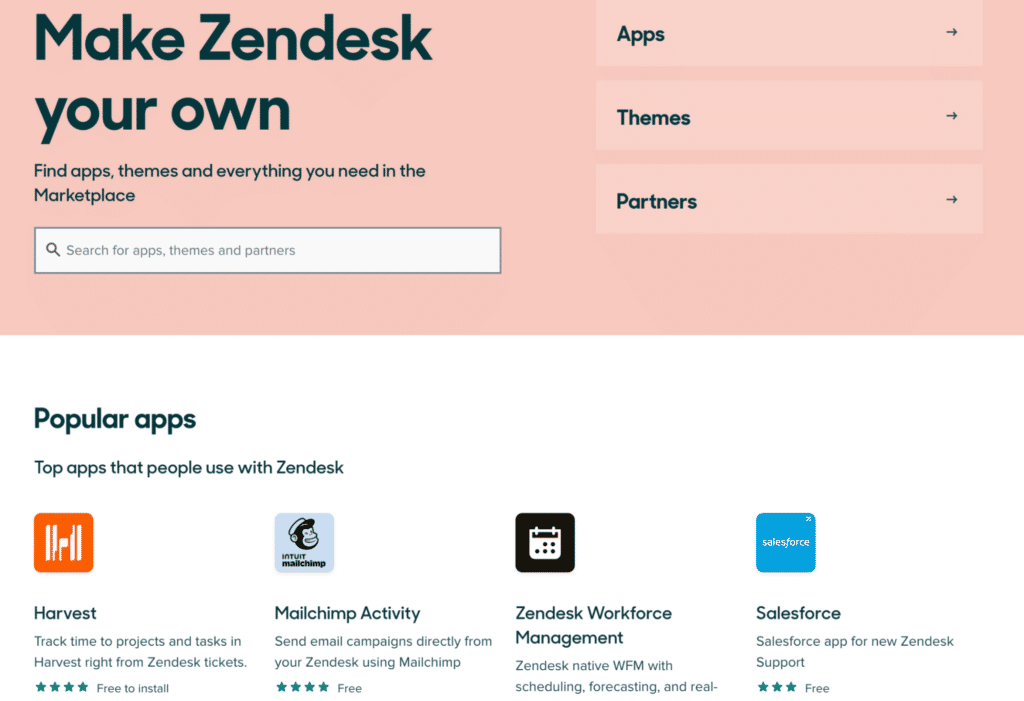
Extensive App Marketplace:
Zendesk’s marketplace offers over 1,200 apps and integrations, including popular CRM, e-commerce, social media, and analytics tools.
Ease of Integration:
Integrating third-party applications with Zendesk is typically simple and requires minimal setup. Many integrations are plug-and-play, with clear instructions and support documentation.
Popular Integrations:
Zendesk integrates seamlessly with popular platforms such as Salesforce, Slack, Shopify, Google Analytics, and Microsoft Teams, enabling streamlined workflows.
Custom Integrations:
Zendesk provides robust APIs for businesses with specific needs, allowing for custom integrations. This flexibility ensures that Zendesk can be tailored to meet unique business requirements. The platform also offers extensive resources for developers, including API documentation, SDKs, and a developer community, making creating and managing custom integrations easier.
Hubspot
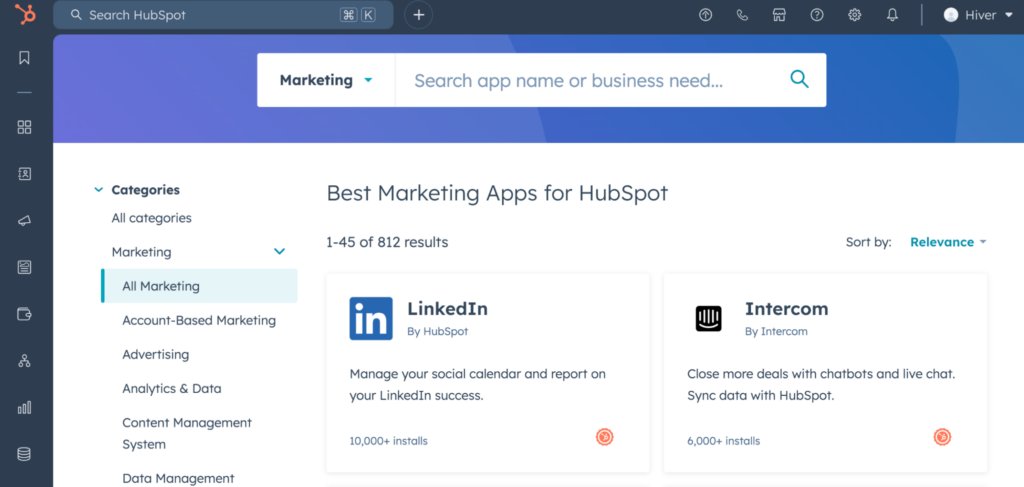
Integrated Ecosystem:
HubSpot offers a more integrated ecosystem, particularly with its suite of tools, such as Marketing Hub, Sales Hub, and CMS Hub. These provide a unified experience without needing multiple third-party integrations.
Growing Marketplace:
HubSpot’s App Marketplace is growing and offers over 1000 integrations across CRM, marketing, sales, and customer service categories, although smaller than Zendesk’s.
Ease of Use:
Integrations with HubSpot are designed to be user-friendly, with simple installation and configuration processes. The interface is intuitive, making it accessible even for those without technical expertise.
Popular Integrations:
HubSpot integrates seamlessly with major platforms like Salesforce, Slack, Zoom, and Gmail, enhancing the capabilities of HubSpot Service Hub and ensuring smooth operations.
Custom Integrations:
HubSpot provides custom integration APIs to help businesses connect with tools and systems unavailable in the marketplace. This allows businesses to be flexible and adapt to their specific needs.
Developer Support:
HubSpot offers extensive support for developers, including detailed API documentation, tutorials, and a developer forum to help them create custom integrations.
Key Takeaway
Zendesk is better for organizations primarily focused on customer support and needing a wide array of service-related integrations. On the other hand, Hubspot is Ideal for businesses looking for an all-in-one platform that integrates marketing, sales, and service tools.
…Or simply choose Hiver, a better alternative.
Hiver is a customer support tool that integrates seamlessly into Gmail, streamlining business support workflows. Let’s explore Hiver’s offerings:
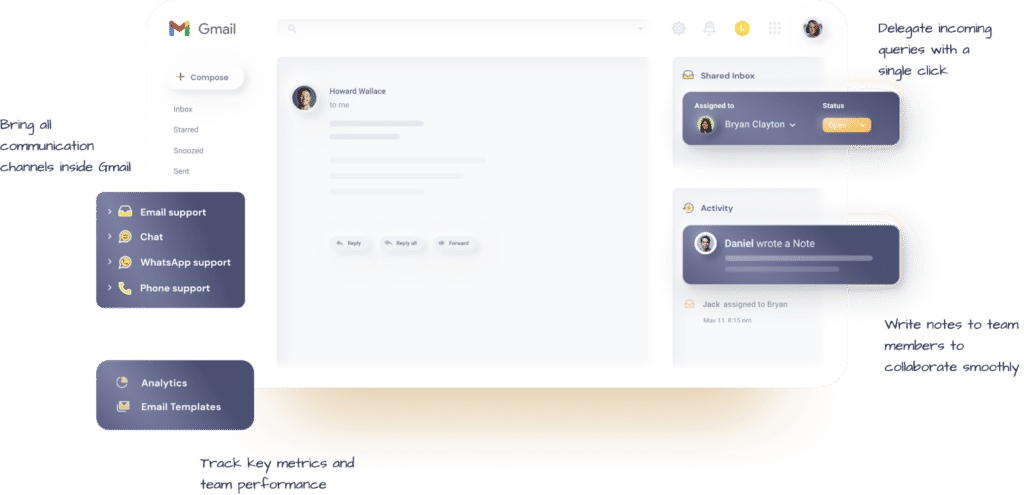
1. Gmail Interface
Hiver’s prime feature is its seamless integration inside your inbox, eliminating the need to learn new software. Teams can handle customer queries from their familiar Gmail interface, leading to better adoption and less learning time.
2. Shared Inboxes
Hiver turns your inbox into a shared inbox, which is ideal for support teams managing high email volumes. Team members can collectively access and respond to emails from a common address, like [email protected], ensuring every customer query is addressed.
3. Email Management
Customer emails can be allocated to specific team members, clarifying responsibilities and fostering accountability. Hiver also tracks these emails, allowing managers to oversee progress and guarantee timely replies.
4. Enhancing Collaboration
Real-Time Collaborative Email Drafting: Teams can co-write emails in real-time, which is valuable for crafting detailed responses to complex queries.
Email Notes: Team members can add private notes to emails, facilitating internal communication without external chats or email forwarding. These notes are not visible to customers.

Collision Detection: Hiver alerts when multiple team members reply to the same email, preventing overlap and better organizing communication.
5. Advanced Automation
Hiver boosts workflow efficiency through automation:
- Automatic Email Routing: Hiver’s automatic email routing allocates emails to team members based on predefined criteria like content, sender, or subject line. This targeted assignment ensures quick, appropriate response and workload balance. For example, If a customer sends an email with the subject “Urgent software issue,” Hiver automatically routes it to the technical support team. Alternatively, an email from a known VIP client could be directed to a senior customer service representative, ensuring high-priority handling.
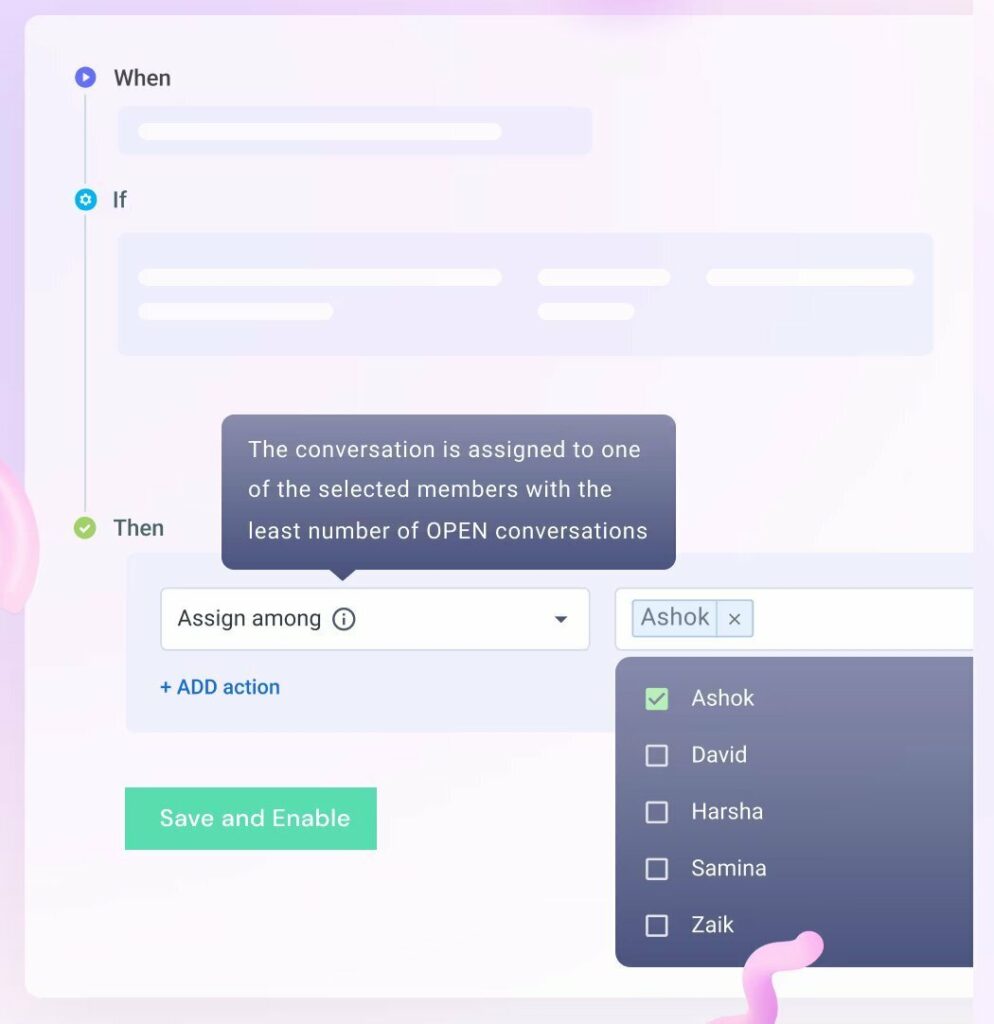
- SLA (Service Level Agreement) Management: Hiver helps set SLA reminders and warnings to ensure timely responses to customer queries, boost efficiency, and maintain high service standards. Hiver sets a reminder for a response within 2 hours for high-priority queries. If the query isn’t addressed within this timeframe, the system warns the team manager to ensure adherence to the agreed SLA.
- Workflow Automation: Hiver automates tasks like categorizing, tagging, and marking emails to save time and reduce errors. For example, when a customer sends feedback, Hiver automatically tags it as ‘Customer Feedback.’ Similarly, emails with “invoice” are tagged and categorized under ‘Billing’ to sort finance-related queries easily.
- Harvey:Harvey, the AI assistant in Hiver, has a Thank You Detection feature programmed to recognize when customers send ‘Thank You’ responses after their issues have been resolved and the conversation has been closed. Typically, such responses don’t require further action but can inadvertently reopen closed conversations.
6. Analytics and Reporting
- Response and Resolution Tracking: Hiver monitors how quickly teams respond to and resolve issues – key metrics for evaluating customer support effectiveness.
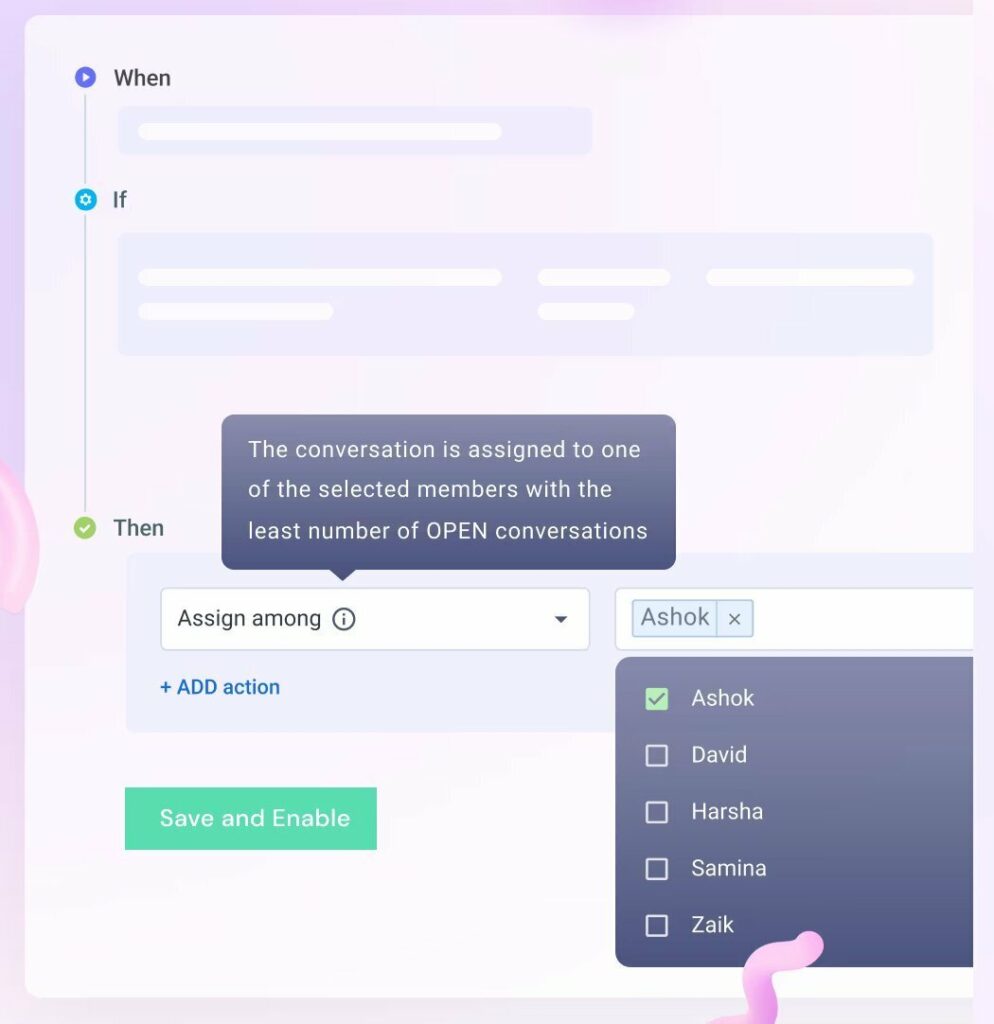
- Performance Insights: It offers a detailed analysis of individual team members’ performance, aiding in identifying training needs or recognizing top performers.
- Custom Dashboards: Users can create dashboards tailored to their specific metrics, offering customized analysis.
- Data Export: Hiver enables data export for deeper analysis or integration with other tools.
7. Pricing Structure
As of 2024, Hiver offers four pricing tiers:
Free Plan: Hiver has a forever free plan that comes with all the essential help desk features. You get a shared inbox, multiple channels (live chat, WhatsApp, phone etc.),an external knowledge base, as well as collaboration features like internal notes.
Lite Plan: The $19 per user per month option includes basic customer service tools, supports 2 shared inboxes and 10 users per inbox, and provides mobile app access, onboarding support, and 24×7 chat and email support.
Pro Plan: Priced at $49 per user/month, it includes voice calls, advanced automation, comprehensive analytics, and integrations with tools like Asana and Salesforce. Allows for 5 shared inboxes and 50 shared labels.
Elite Plan: For $79 per user/month, this plan caters to high-volume needs with advanced features like HIPAA compliance and a dedicated success manager. It includes unlimited shared inboxes, labels, users, and features such as Harvey, Hiver’s AI Bot.
8. Proactive Customer Support
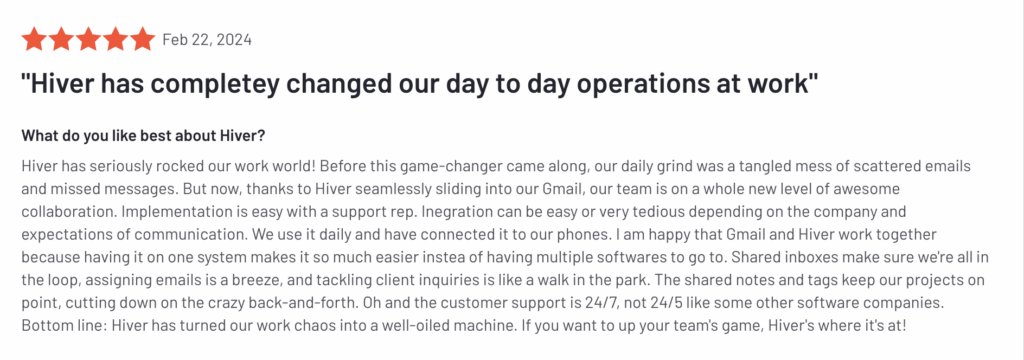
With Hiver, clients receive 24×7 proactive support across all service plans, guaranteeing immediate and expert help whenever needed. This commitment to constant availability reflects Hivers’ dedication to client satisfaction and operational excellence, ensuring that quality support is a continuous, integral part of the user experience.
Each plan has a 7-day free trial, with no credit card needed for signing up.
Hiver’s diverse plans suit various business sizes and needs, making it a comprehensive customer support platform within your inbox.













